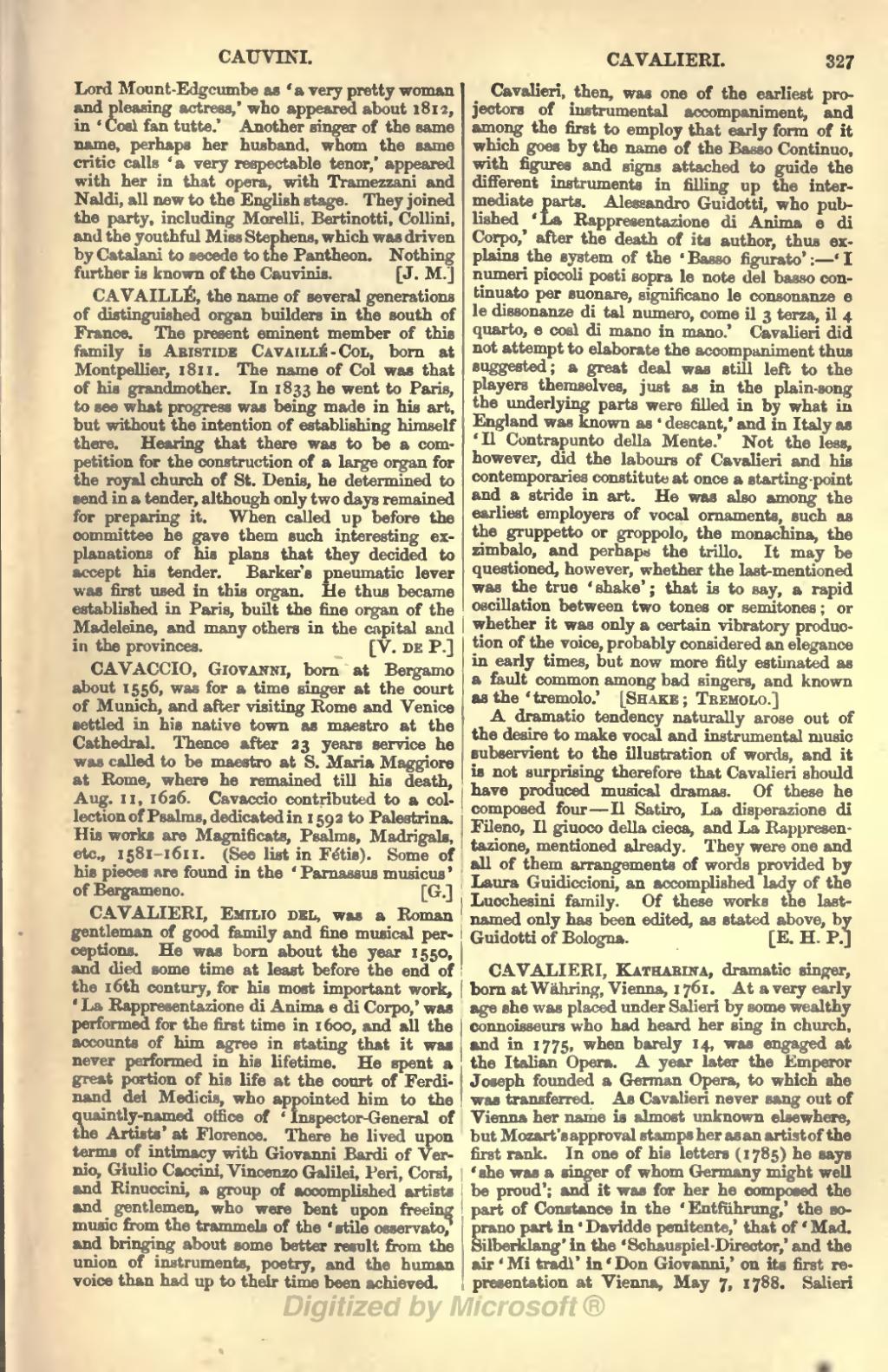Lord Mount-Edgcumbe as 'a very pretty woman and pleasing actress,' who appeared about 1812, in 'Così fan tutte.' Another singer of the same name, perhaps her husband, whom the same critic calls 'a very respectable tenor,' appeared with her in that opera, with Tramezzani and Naldi, all new to the English stage. They joined the party, including Morelli, Bertinotti, Collini, and the youthful Miss Stephens, which was driven by Catalani to secede to the Pantheon. Nothing further is known of the Cauvinis.
CAVAILLÉ, the name of several generations of distinguished organ builders in the south of France. The present eminent member of this family is Aristide Cavaillé-Col, born at Montpellier, 1811. The name of Col was that of his grandmother. In 1833 he went to Paris, to see what progress was being made in his art, but without the intention of establishing himself there. Hearing that there was to be a competition for the construction of a large organ for the royal church of St. Denis, he determined to send in a tender, although only two days remained for preparing it. When called up before the committee he gave them such interesting explanations of his plans that they decided to accept his tender. Barker's pneumatic lever was first used in this organ. He thus became established in Paris, built the fine organ of the Madeleine, and many others in the capital and in the provinces. [App. p.583 adds "date of death, Jan. 1886."]
CAVACCIO, Giovanni, born at Bergamo about 1556, was for a time singer at the court of Munich, and after visiting Rome and Venice settled in his native town as maestro at the Cathedral. Thence after 23 years service he was called to be maestro at S. Maria Maggiore at Rome, where he remained till his death, Aug. 11, 1626. Cavaccio contributed to a collection of Psalms, dedicated in 1592 to Palestrina. His works are Magnificats, Psalms, Madrigals, etc., 1581–1611. (See list in Fétis). Some of his pieces are found in the 'Parnassus musicus' of Bergameno.
CAVALIERI, Emilio del, was a Roman gentleman of good family and fine musical perceptions. He was born about the year 1550, and died some time at least before the end of the 16th century, for his most important work, 'La Rappresentazione di Anima e di Corpo,' was performed for the first time in 1600, and all the accounts of him agree in stating that it was never performed in his lifetime. He spent a great portion of his life at the court of Ferdinand del Medicis, who appointed him to the quaintly-named office of 'Inspector-General of the Artists' at Florence. There he lived upon terms of intimacy with Giovanni Bardi of Vernio, Giulio Caccini, Vincenzo Galilei, Peri, Corsi, and Rinuccini, a group of accomplished artists and gentlemen, who were bent upon freeing music from the trammels of the 'stile osservato,' and bringing about some better result from the union of instruments, poetry, and the human voice than had up to their time been achieved.
Cavalieri, then, was one of the earliest projectors of instrumental accompaniment, and among the first to employ that early form of it which goes by the name of the Basso Continuo, with figures and signs attached to guide the different instruments in filling up the intermediate parts. Alessandro Guidotti, who published 'La Rappresentazione di Anima e di Corpo,' after the death of its author, thus explains the system of the 'Basso figurato':—'I numeri piccoli posti sopra le note del basso continuato per suonare, significano le consonanze e le dissonanze di tal numero, come il 3 terza, il 4 quarto, e così di mano in mano.' Cavalieri did not attempt to elaborate the accompaniment thus suggested; a great deal was still left to the players themselves, just as in the plain-song the underlying parts were filled in by what in England was known as 'descant,' and in Italy as 'Il Contrapunto della Mente.' Not the less, however, did the labours of Cavalieri and his contemporaries constitute at once a starting-point and a stride in art. He was also among the earliest employers of vocal ornaments, such as the gruppetto or groppolo, the monachina, the zimbalo, and perhaps the trillo. It may be questioned, however, whether the last-mentioned was the true 'shake'; that is to say, a rapid oscillation between two tones or semitones; or whether it was only a certain vibratory production of the voice, probably considered an elegance in early times, but now more fitly estimated as a fault common among bad singers, and known as the 'tremolo.' [Shake; Tremolo.]
A dramatic tendency naturally arose out of the desire to make vocal and instrumental music subservient to the illustration of words, and it is not surprising therefore that Cavalieri should have produced musical dramas. Of these he composed four—Il Satiro, La disperazione di Fileno, Il giuoco della cieca, and La Rappresentazione, mentioned already. They were one and all of them arrangements of words provided by Laura Guidiccioni, an accomplished lady of the Lucchesini family. Of these works the last-named only has been edited, as stated above, by Guidotti of Bologna.
CAVALIERI, Katharina, dramatic singer, born at Währing, Vienna, 1761. At a very early age she was placed under Salieri by some wealthy connoisseurs who had heard her sing in church, and in 1775, when barely 14, was engaged at the Italian Opera. A year later the Emperor Joseph founded a German Opera, to which she was transferred. As Cavalieri never sang out of Vienna her name is almost unknown elsewhere, but Mozart's approval stamps her as an artist of the first rank. In one of his letters (1785) he says 'she was a singer of whom Germany might well be proud'; and it was for her he composed the part of Constance in the 'Entführung,' the soprano part in 'Davidde penitente,' that of 'Mad. Silberklang' in the 'Schauspiel-Director,' and the air 'Mi tradì in 'Don Giovanni,' on its first representation at Vienna, May 7, 1788. Salieri
